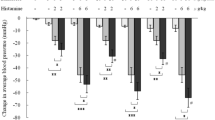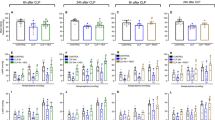Summary
In the present studies, the efficacy of dopexamine hydrochloride, a novel DA1-receptor and β2-adrenoceptor agonist in preventing deterioration of cardiovascular function in a canine model of hemorrhagic shock was investigated. Pentobarbital-anesthetized dogs were allowed to bleed into a height-regulated reservoir and the hypotensive state (about 40 mmHg) was maintained for a period of 150 min. Subsequently, blood was reinfused and recoveries in various hemodynamic variables were monitored for an additional period of 120 min. Either aqueous solvent or dopexamine HCl was randomly selected for i. v. infusion beginning 30 min before reinfusion of the blood and until the termination of the experiment.
In the solvent-treated control group, various cardiovascular variables such as cardiac output, stroke volume, celiac and superior mesenteric arterial blood flows progressively declined to 50% or less of the basal values; these changes were associated with sustained increases in the regional as well as systemic vascular resistances. Dopexamine infusion lowered vascular resistances and facilitated recoveries in various hemodynamic variables to 80% to 100% of the basal values after reinfusion of the shed blood. With the exception of a transient inotropic effect during reinfusion in the dopexamine treated group, there were no essential alterations in the myocardial contractility, during the hypotensive state and/or after reinfusion of the blood.
Hence, the results indicate that the efficacy of dopexamine to reduce vascular resistance by actions at DA1-receptors and β2-adrenoceptors would account for its ability to improve myocardial performance (secondary to reductions in afterload) and restoration of mesenteric and celiac hemodynamics. These salutary effects of dopexamine could be useful in the clinical management of hemorrhagic shock.
Similar content being viewed by others
References
Baumann G, Felix SB, Filcek SAL (1990) Usefulness of dopexamine hydrochloride versus dobutamine in chronic congestive heart failure and the effects on hemodynamics and urine output. Am J Cardiol 65:748–754
Bellamy RF, Pedersen DC, Guzman de LR (1984) Organ blood flow and cause of death following massive hemorrhage. Circ Shock 14:113–127
Bethea HL, Jones CE, Crowell JW (1972) Effect of pharmacologic coronary flow augmentation on cardiac function in hypotension. Am J Physiol 22:95–105
Brown RA, Dixon J, Farmer JB, Hall JC, Humphries RG, Ince F, O'Connor SE, Simpson WT, Smith GW (1985) Dopexamine: a novel agonist at peripheral dopamine receptors and β2 adrenoceptors. Br J Pharmacol 85:599–608
Cavero I, Lokhandwala MF, Buckley JP, Jandhyala BS (1974) The effect of (−)-Δ9-trans-tetrahydrochannabinol on myocardial contractility and venous return in anesthetized dogs. Eur J Pharmacol 29:74–82
Chintala MS, Jandhyala BS (1990) Renal failure in hemorrhagic shock in dogs: Salutary effects of the calcium entry blocker felodipine. Naunyn-Schmiedeberg's Arch Pharmacol 341:357–363
Chintala MS, Lokhandwala MF, Jandhyala BS (1990) Protective effects of dopexamine hydrochloride in renal failure after acute hemorrhage in anesthetized dogs. J Auton Pharmacol 10 [Suppl]:S95-S102
Crowell JW, Guyton A (1961) Evidence favouring a cardiac mechanism in irreversible hemorrhagic shock. Am J Physiol 201:893–901
Gifford RM, MacCannel KL, McNay JL, Hass JA (1986) Changes in regional blood flow induced by dopamine and isoproterenol during experimental hemorrhagic shock. Can J Physiol Pharmacol 46:847–851
Glaser O, Page IH (1948) Experimental hemorrhagic shock: A study of its production and treatment. Am J Physiol 154:197–315
Glenn TM, Lefer AM (1971) Significance of splanchnic proteases in the production of a toxic factor in hemorrhagic shock. Clin Res 29:338–349
Granata L, Huvos A, Pasque A, Gregg DE (1969) Left coronary hemodynamics during hemorrhagic hypotension and shock. Am J Physiol 216:1583–1588
Grega GJ, Kinnard WJ, Buckley JP (1967) Effect of nylidrin, isoproterenol and phenoxybenzamine on dogs subjected to hemorrhagic shock. Circ Res 20:253–261
Harried AT, Ginos JZ, Ekas Jr RD, Jandhyala BS, Lokhandwala MF (1983) Renal hemodynamics in hemorrhagic hypotension: Studies on the effects of pre- and postjunctional dopamine receptor agonists. J Card Vase Pharmacol 5:207–212
Jandhyala BS, Steenberg ML, Perel JM, Manian A, Buckley JP (1977) Effects of several tricyclic antidepressants on the hemodynamics and myocardial contractility of the anesthetized dogs. Eur J Pharmacol 42:403–410
Kappagoda CTR, Linden RJ (1978) The use of SI units in cardiovascular studies. Card Vase Res 10:141–148
Lefer AM (1987) Interaction between myocardial depressant factor and vasoactive mediators with ischemia and shock. Am J Physiol 252:R193-R205
Lefer AM, Martin J (1970) Relationship of plasma peptides to the myocardial depressant factor in hemorrhagic shock in cats. Circ Res 26:59–69
Leier CV, Binkley PF, Carpenter J, Randolph PH, Unverferth DV (1988) Cardiovascular pharmacology of dopexamine in low output congestive heart failure. Am J Cardiol 62:94–99
Lokhandwala MF (1990) Renal actions of dopexamine hydrochloride. Clin Intens Care 1:163–174
Lundgren O, Lundwall J, Mellander S (1964) Range of sympathetic discharge and reflex vascular adjustment in skeletal muscle during hemorrhage. Acta Physiol Scand 62:380–390
Markov AK, Oglethorpe N, Young DB, Hellems HK (1981) Irreversible hemorrhagic shock. Treatment and cardiac pathophysiology. Circ Shock 8:9–19
Mason DT (1969) Usefulness and limitations of the rate of rise of intraventricular pressure (dp/dt) in the evaluation of myocardial contractility in man. Am J Cardiol 23:516–520
Orchard CH, Kentish JC (1990) Effects of changes of pH on the contractile function of cardiac muscle. Am J Physiol 258:C967–981
Prys-Roberts C, Gersch BJ, Baker AB, Reuben S (1972) The effects of halothane on interactions between myocardial contractility, aortic impedence and left ventricular performance: Theoretical considerations and results. Br J Anesth 44:634–648
Sabouni M, Hodge K, Jandhyala BS (1988) Restoration of renal and mesenteric hemodynamics by felodipine in a canine model of hemorrhage shock. Naunyn-Schmiedeberg's Arch Pharmacol 337:465–470
Sarnoff SJ, Cage RB, Waithe PE, Issacs JP (1954) Insufficient coronary flow and myocardial failure as a complicating factor in late hemorrhagic shock. Am J Physiol 176:439–446
Selkurt EE, Alexander RS, Patterson MB (1947) The role of the mesenteric circulation in the irreversibility of hemorrhagic shock. Am J Physiol 149:732–743
Share L (1968) Control of plasma ADH: Role of atrial and arterial receptors. Am J Physiol 215:1384–1389
Truniger BS, Rosen SM, Grandchamp A, Strebel H, Kriek HR (1971) Redistribution of renal blood flow in hemorrhagic hypotension: Role of renal nerves and circulating catecholamines. Eur J Clin Invest 1:277–280
Author information
Authors and Affiliations
Additional information
Correspondence to B. S. Jandhyala at the above address
Rights and permissions
About this article
Cite this article
Chintala, M.S., Moore, R.J., Lokhandwala, M.F. et al. Evaluation of the effects of dopexamine, a novel DA1 receptor and β2-adrenoceptor agonist, on cardiac function and splanchnic circulation in a canine model of hemorrhagic shock. Naunyn-Schmiedeberg's Arch Pharmacol 347, 296–300 (1993). https://doi.org/10.1007/BF00167448
Received:
Accepted:
Issue Date:
DOI: https://doi.org/10.1007/BF00167448




